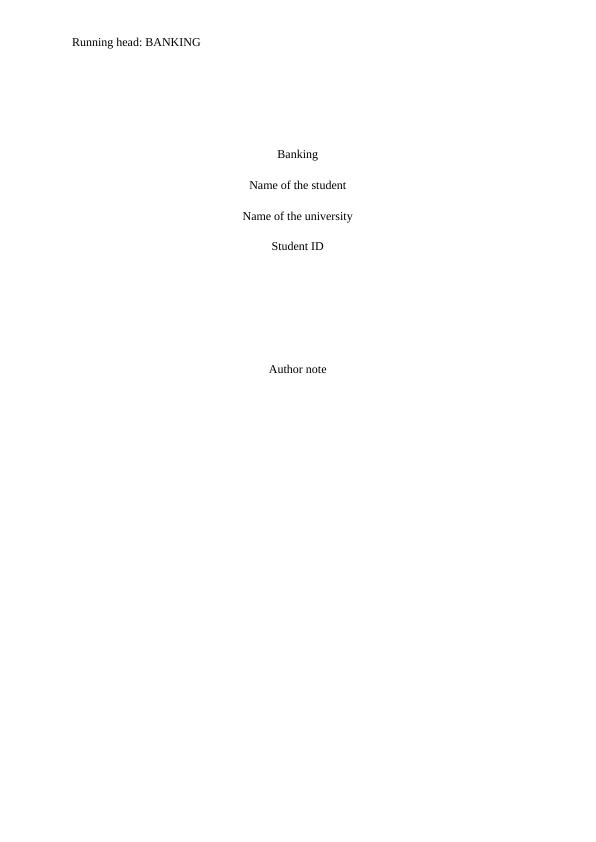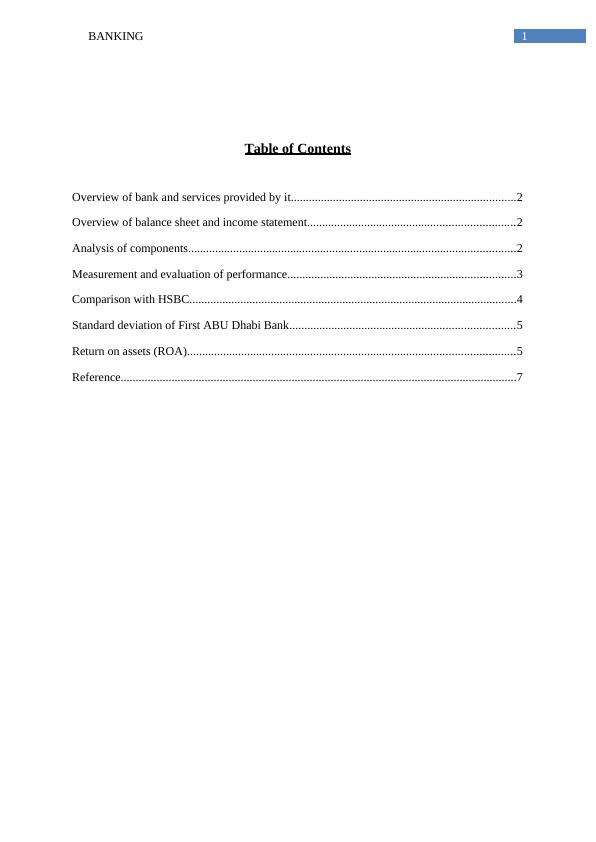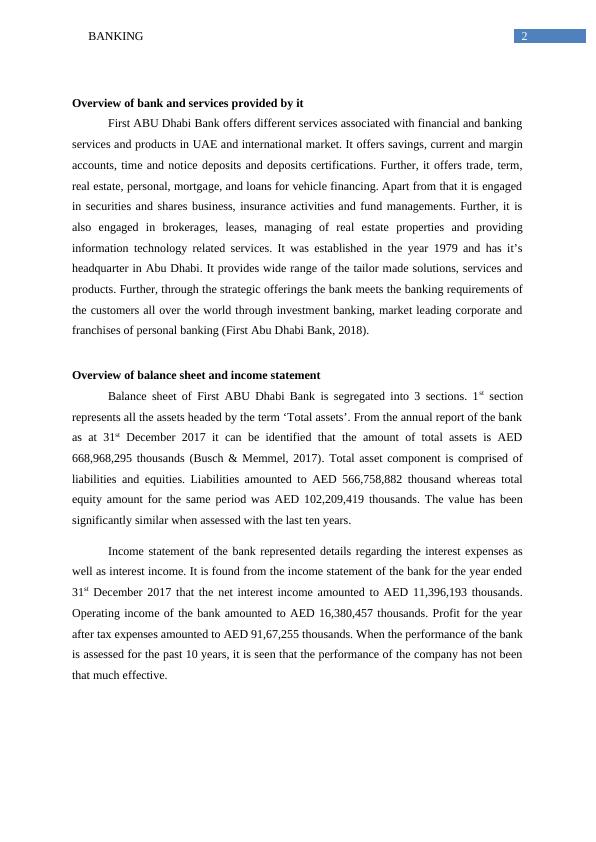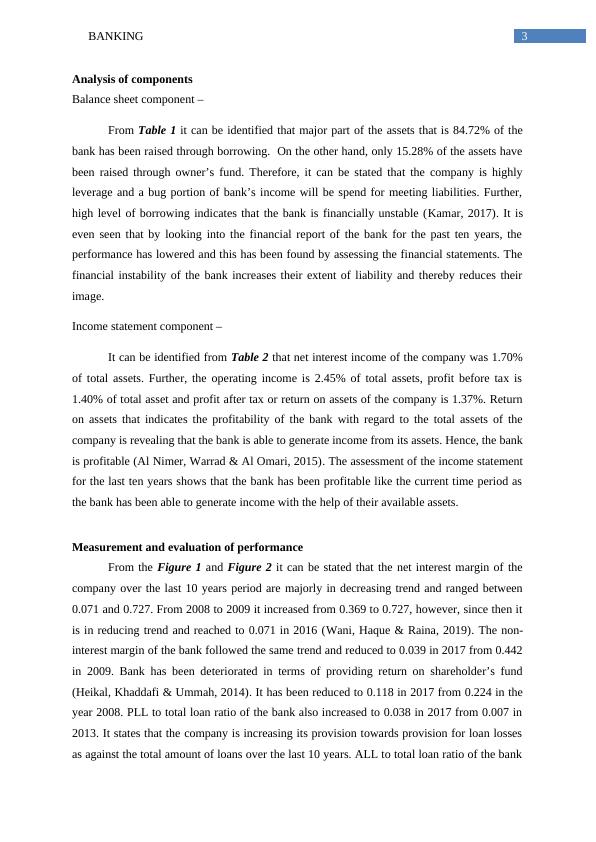Analysis of First Abu Dhabi Bank: Balance Sheet, Income Statement, Performance and Comparison with HSBC
Added on 2023-06-04
17 Pages2053 Words450 Views
Running head: BANKING
Banking
Name of the student
Name of the university
Student ID
Author note
Banking
Name of the student
Name of the university
Student ID
Author note

1BANKING
Table of Contents
Overview of bank and services provided by it...........................................................................2
Overview of balance sheet and income statement.....................................................................2
Analysis of components.............................................................................................................2
Measurement and evaluation of performance............................................................................3
Comparison with HSBC.............................................................................................................4
Standard deviation of First ABU Dhabi Bank...........................................................................5
Return on assets (ROA).............................................................................................................5
Reference....................................................................................................................................7
Table of Contents
Overview of bank and services provided by it...........................................................................2
Overview of balance sheet and income statement.....................................................................2
Analysis of components.............................................................................................................2
Measurement and evaluation of performance............................................................................3
Comparison with HSBC.............................................................................................................4
Standard deviation of First ABU Dhabi Bank...........................................................................5
Return on assets (ROA).............................................................................................................5
Reference....................................................................................................................................7

2BANKING
Overview of bank and services provided by it
First ABU Dhabi Bank offers different services associated with financial and banking
services and products in UAE and international market. It offers savings, current and margin
accounts, time and notice deposits and deposits certifications. Further, it offers trade, term,
real estate, personal, mortgage, and loans for vehicle financing. Apart from that it is engaged
in securities and shares business, insurance activities and fund managements. Further, it is
also engaged in brokerages, leases, managing of real estate properties and providing
information technology related services. It was established in the year 1979 and has it’s
headquarter in Abu Dhabi. It provides wide range of the tailor made solutions, services and
products. Further, through the strategic offerings the bank meets the banking requirements of
the customers all over the world through investment banking, market leading corporate and
franchises of personal banking (First Abu Dhabi Bank, 2018).
Overview of balance sheet and income statement
Balance sheet of First ABU Dhabi Bank is segregated into 3 sections. 1st section
represents all the assets headed by the term ‘Total assets’. From the annual report of the bank
as at 31st December 2017 it can be identified that the amount of total assets is AED
668,968,295 thousands (Busch & Memmel, 2017). Total asset component is comprised of
liabilities and equities. Liabilities amounted to AED 566,758,882 thousand whereas total
equity amount for the same period was AED 102,209,419 thousands. The value has been
significantly similar when assessed with the last ten years.
Income statement of the bank represented details regarding the interest expenses as
well as interest income. It is found from the income statement of the bank for the year ended
31st December 2017 that the net interest income amounted to AED 11,396,193 thousands.
Operating income of the bank amounted to AED 16,380,457 thousands. Profit for the year
after tax expenses amounted to AED 91,67,255 thousands. When the performance of the bank
is assessed for the past 10 years, it is seen that the performance of the company has not been
that much effective.
Overview of bank and services provided by it
First ABU Dhabi Bank offers different services associated with financial and banking
services and products in UAE and international market. It offers savings, current and margin
accounts, time and notice deposits and deposits certifications. Further, it offers trade, term,
real estate, personal, mortgage, and loans for vehicle financing. Apart from that it is engaged
in securities and shares business, insurance activities and fund managements. Further, it is
also engaged in brokerages, leases, managing of real estate properties and providing
information technology related services. It was established in the year 1979 and has it’s
headquarter in Abu Dhabi. It provides wide range of the tailor made solutions, services and
products. Further, through the strategic offerings the bank meets the banking requirements of
the customers all over the world through investment banking, market leading corporate and
franchises of personal banking (First Abu Dhabi Bank, 2018).
Overview of balance sheet and income statement
Balance sheet of First ABU Dhabi Bank is segregated into 3 sections. 1st section
represents all the assets headed by the term ‘Total assets’. From the annual report of the bank
as at 31st December 2017 it can be identified that the amount of total assets is AED
668,968,295 thousands (Busch & Memmel, 2017). Total asset component is comprised of
liabilities and equities. Liabilities amounted to AED 566,758,882 thousand whereas total
equity amount for the same period was AED 102,209,419 thousands. The value has been
significantly similar when assessed with the last ten years.
Income statement of the bank represented details regarding the interest expenses as
well as interest income. It is found from the income statement of the bank for the year ended
31st December 2017 that the net interest income amounted to AED 11,396,193 thousands.
Operating income of the bank amounted to AED 16,380,457 thousands. Profit for the year
after tax expenses amounted to AED 91,67,255 thousands. When the performance of the bank
is assessed for the past 10 years, it is seen that the performance of the company has not been
that much effective.

3BANKING
Analysis of components
Balance sheet component –
From Table 1 it can be identified that major part of the assets that is 84.72% of the
bank has been raised through borrowing. On the other hand, only 15.28% of the assets have
been raised through owner’s fund. Therefore, it can be stated that the company is highly
leverage and a bug portion of bank’s income will be spend for meeting liabilities. Further,
high level of borrowing indicates that the bank is financially unstable (Kamar, 2017). It is
even seen that by looking into the financial report of the bank for the past ten years, the
performance has lowered and this has been found by assessing the financial statements. The
financial instability of the bank increases their extent of liability and thereby reduces their
image.
Income statement component –
It can be identified from Table 2 that net interest income of the company was 1.70%
of total assets. Further, the operating income is 2.45% of total assets, profit before tax is
1.40% of total asset and profit after tax or return on assets of the company is 1.37%. Return
on assets that indicates the profitability of the bank with regard to the total assets of the
company is revealing that the bank is able to generate income from its assets. Hence, the bank
is profitable (Al Nimer, Warrad & Al Omari, 2015). The assessment of the income statement
for the last ten years shows that the bank has been profitable like the current time period as
the bank has been able to generate income with the help of their available assets.
Measurement and evaluation of performance
From the Figure 1 and Figure 2 it can be stated that the net interest margin of the
company over the last 10 years period are majorly in decreasing trend and ranged between
0.071 and 0.727. From 2008 to 2009 it increased from 0.369 to 0.727, however, since then it
is in reducing trend and reached to 0.071 in 2016 (Wani, Haque & Raina, 2019). The non-
interest margin of the bank followed the same trend and reduced to 0.039 in 2017 from 0.442
in 2009. Bank has been deteriorated in terms of providing return on shareholder’s fund
(Heikal, Khaddafi & Ummah, 2014). It has been reduced to 0.118 in 2017 from 0.224 in the
year 2008. PLL to total loan ratio of the bank also increased to 0.038 in 2017 from 0.007 in
2013. It states that the company is increasing its provision towards provision for loan losses
as against the total amount of loans over the last 10 years. ALL to total loan ratio of the bank
Analysis of components
Balance sheet component –
From Table 1 it can be identified that major part of the assets that is 84.72% of the
bank has been raised through borrowing. On the other hand, only 15.28% of the assets have
been raised through owner’s fund. Therefore, it can be stated that the company is highly
leverage and a bug portion of bank’s income will be spend for meeting liabilities. Further,
high level of borrowing indicates that the bank is financially unstable (Kamar, 2017). It is
even seen that by looking into the financial report of the bank for the past ten years, the
performance has lowered and this has been found by assessing the financial statements. The
financial instability of the bank increases their extent of liability and thereby reduces their
image.
Income statement component –
It can be identified from Table 2 that net interest income of the company was 1.70%
of total assets. Further, the operating income is 2.45% of total assets, profit before tax is
1.40% of total asset and profit after tax or return on assets of the company is 1.37%. Return
on assets that indicates the profitability of the bank with regard to the total assets of the
company is revealing that the bank is able to generate income from its assets. Hence, the bank
is profitable (Al Nimer, Warrad & Al Omari, 2015). The assessment of the income statement
for the last ten years shows that the bank has been profitable like the current time period as
the bank has been able to generate income with the help of their available assets.
Measurement and evaluation of performance
From the Figure 1 and Figure 2 it can be stated that the net interest margin of the
company over the last 10 years period are majorly in decreasing trend and ranged between
0.071 and 0.727. From 2008 to 2009 it increased from 0.369 to 0.727, however, since then it
is in reducing trend and reached to 0.071 in 2016 (Wani, Haque & Raina, 2019). The non-
interest margin of the bank followed the same trend and reduced to 0.039 in 2017 from 0.442
in 2009. Bank has been deteriorated in terms of providing return on shareholder’s fund
(Heikal, Khaddafi & Ummah, 2014). It has been reduced to 0.118 in 2017 from 0.224 in the
year 2008. PLL to total loan ratio of the bank also increased to 0.038 in 2017 from 0.007 in
2013. It states that the company is increasing its provision towards provision for loan losses
as against the total amount of loans over the last 10 years. ALL to total loan ratio of the bank

End of preview
Want to access all the pages? Upload your documents or become a member.
Related Documents
FIN6001 Assignment Financial Management (FM)lg...
|13
|1896
|103
Preparation of Financial Statement and Evaluating Balance Sheetlg...
|11
|2995
|61
Accounting Fundamentals: Preparation of Financial Statements and Ratio Analysislg...
|10
|2096
|168
Accounting Fundamentals: Profit & Loss, Financial Position, Ratio Calculations and Performance Evaluationlg...
|11
|1988
|408
Accounting Fundamentals in Business Management - Deskliblg...
|12
|2312
|292
Financial Analysislg...
|8
|1520
|23
